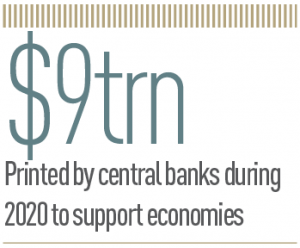
When the virus came, the lockdowns, travel bans, and restrictions in response to it, decimated the global economy. To reduce the damage, state authorities put anti-virus and economic recovery measures in motion. Now, the global economy is slowly trying to recover, but the damage is reflected in the markets where the effects of supportive economic activities continue to alter the landscape.
For many traders, it can be hard to orient oneself in such a changing environment. This article was created to help them. It observes and structures the main economic trends. Also, it provides some specific trading strategy recommendations and helps traders better understand the changing global economic environment. As a result, their trades may be better planned and aligned with the current market trends, and their overall ‘survival’ ratio may possibly increase.
Response to the pandemic
The pandemic and resulting lockdowns severely impacted the global economy. Activity in the manufacturing sector, a core element of economic growth, sharply declined at the peak of the pandemic response. According to IHS Markit, in May 2020, the US PMI fell to a record low of 36.1. In the EU, the same indicator was at 33.4. Against this backdrop, stock markets began to slide. The Dow Jones fell more than 35 percent, and the Euro Stoxx 50 dropped more than 40 percent. To fix the situation, developed states put in place extensive supportive campaigns to restart their economies. Primarily, their central banks significantly reduced interest rates. Also, they launched emergency stimulus programmes, effectively printing more money.
As a result, the money supply in the EU and the US jumped to record highs. In the US, the M1 money supply almost tripled. The American economy has never seen such a growth rate in all its history. The supportive campaigns worked. Together with the loose monetary policy, the stimulus made the dollar fall. The central banks jump-started the stock market and their economies.
Inflation as a side effect
Central banks across the world printed nearly $9trn in 2020 to support economies. They managed to revive the economies, but their measures have led to inflation growth. In the US, it is now 200 basis points above the target value. Other developed states are suffering a similar side effect. In the meantime, the demand for international trade and domestic consumption is at historic lows. US retail sales haven’t grown by one percent yet. August saw a weak growth rate of 0.7 percent, and the second quarter of 2021 had –1.8 percent. China has a similar problem. Moreover, the world may fall into another recession from weakening demand for Chinese products. This problem plagued Europe in 2019 before the pandemic. If it happens again, Europe and Japan will suffer because their economies are export-oriented and have tight trade bonds with China. Also, unlike other G7 countries, their central banks are unlikely to stop the economic stimulus as their GDP growth has only recently surpassed zero. Therefore, while central banks’ actions aided the economies, they are now struggling to find a solution for the side effects for these measures, and inflation is just one of them.
The energy sector crisis
Energy prices are rising, and this issue moves parallel to the inflation problem. In Europe, gas reserves have been significantly depleted partly due to the unusual summer heat and low winter temperatures of 2020. On the other hand, the ECB’s push towards green energy doesn’t help the EU reduce its total energy demand. As a consequence, the EU’s current energy shortage has not been seen since the previous decade. Therefore, it is under pressure to get back to traditional energy such as coal, with Russia as its first supplier to consider.
Russia is now directing most of its coal to Asia under contractual agreements. It simply doesn’t have enough spare to provide to Europe. Furthermore, even if Russia was able to do it, the railway system’s physical limitations wouldn’t allow it to effectively distribute the supplies. As a result, Europe is stuck between the green movement and the effects of 2020, and its energy demand is left unfulfilled. In China, new resistant virus strains have disrupted the normal functioning of the country’s energy systems. The government has imposed restrictions on energy consumption, and businesses lack access to energy inside the country to meet production needs. This is pushing the Chinese state authorities to look for more energy on the global market.

These facts suggest that the global energy demand is increasing. In the oil sector, however, OPEC+ isn’t planning to meet it immediately. On the contrary, its member countries have recently agreed to incrementally increase oil output in the near future. The cartel wants to support energy prices to extract the most profit from them. Recently, natural gas prices exceeded $1,500 per 1,000 cubic meters. Brent crude has crossed $80 against the $60–70 range it had in the summer and is likely to keep going up. October 2018 was the last time Brent was as high. Even after the drone strike on Saudi Arabia’s ARAMCO refineries in 2019, oil prices didn’t leap that much. In the near future, observers expect the oil price to exceed $100.
Partly due to the strong energy demand and progressing economic recovery, the mining and exploration companies are now doing fairly well. The Dow Jones Oil & Gas index reached 470 points, and EuroStoxx Oil & Gas is testing 290 points. Based on these dynamics, we believe most energy stocks may grow through the end of the year. In the meantime, while developed states are trying to move towards green energy, the high carbon energy sector is attracting less global investment and losing appeal to retail traders. That’s why many brokerage companies now educate traders about the cost of missed opportunities while expanding their financial literacy.
How to trade when the stimulus ends
Positive dynamics may not be as likely for the other market sectors. The US Federal Reserve, European Central Bank, Bank of England, and other state financial authorities are about to move from supportive to restrictive monetary policies. Recently, the US Fed Chairman, Jerome Powell, hinted that quantitative easing (QE) will soon be phased out as the US economy is recovering well. When the cutting back of QE is announced, the US dollar will likely go up. In fact, it is already growing on the expectation of the end of stimulus. In the meantime, stocks have an inverse correlation with the US dollar.
Historically, every time the Fed cuts back the QE programme, stock prices mostly drop. In August 2021, the Fed indicated that a shift to the ‘normalisation’ of monetary policy was coming. In response to that, the stock market began to reverse. The impending end of the US Fed’s support is the main reason for the firming US dollar and the decline of blue-chip stocks. Yet, stocks may receive the full hit when the US Fed stops supporting the economy. The asset volume on the balance sheet of the Fed is around $8.36trn. They are currently buying $120bn in treasury bonds and mortgage-backed securities a month. This process fuels interest and prices in various asset groups. But when it stops, a huge void may form. To avoid its impact on asset prices, traders need to select their trade instruments well.
To benefit from the changing market environment, traders and investors need to be aware of its trends and the opportunities it offers
A possible way to do that is to wait until the market correction ends. While waiting, cash may be a safe place to keep funds, but eventually, traders may be able to form new portfolios by buying financial instruments at lower prices. Another way is to buy the so-called ‘defense’ stocks. This refers to those with low or negative beta. It may be American Tower from the financial sector or Bristol Myers from the medical technology sector. Colgate-Palmolive, Procter & Gamble, or PepsiCo from the non-durable consumer goods sector may also do.
These stocks have a fairly low beta. Comparative analysis shows that their capitalisation is undervalued against the industry average. At the same time, these companies have high average profitability and promising revenue and net profit growth dynamics. Alternatively, traders can open short positions on stocks that are in the risk zone upon moving to restrictive monetary policy.
A tactical solution from Olymp Trade
To benefit from the changing market environment, traders and investors need to be aware of its trends and the opportunities it offers. Focusing on the right asset at the right time is key. That, in turn, may be easier with a broker that offers a solid educational base and keeps traders well informed on what’s happening in the market. This is Olymp Trade’s commitment.
Olymp Trade is a trading platform that provides a practical knowledge base through its help centre, made available right from inside the app. It contains various kinds of educational materials from video guides to textual explanations of how Forex trading works.
Traders may apply their knowledge to various types of assets, from Brent to crypto. Moreover, they can do that in various trading modes such as Forex or stock price trades. Equipped with various trading tools ranging from price alerts to market news, they get a trading environment that is as flexible as it is comfortable. Both qualities help traders to effectively orient themselves in the rapidly changing Forex world and reach their financial goals.


